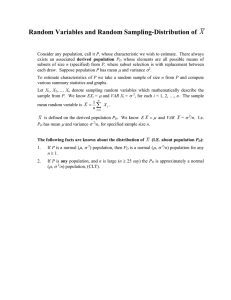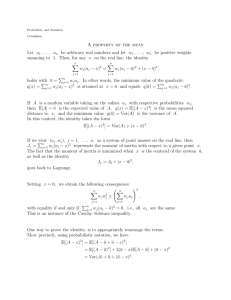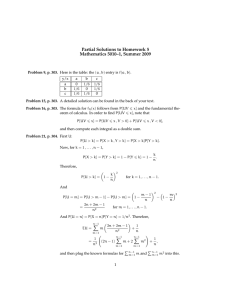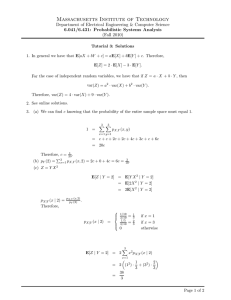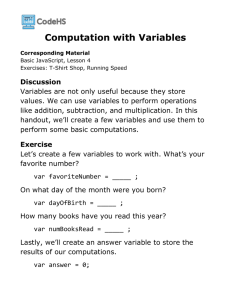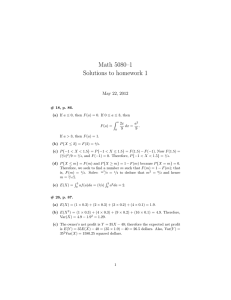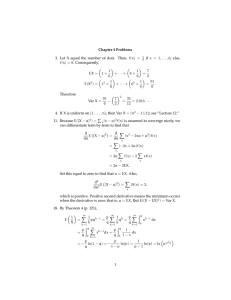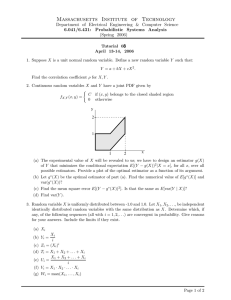Massachusetts Institute of Technology
advertisement
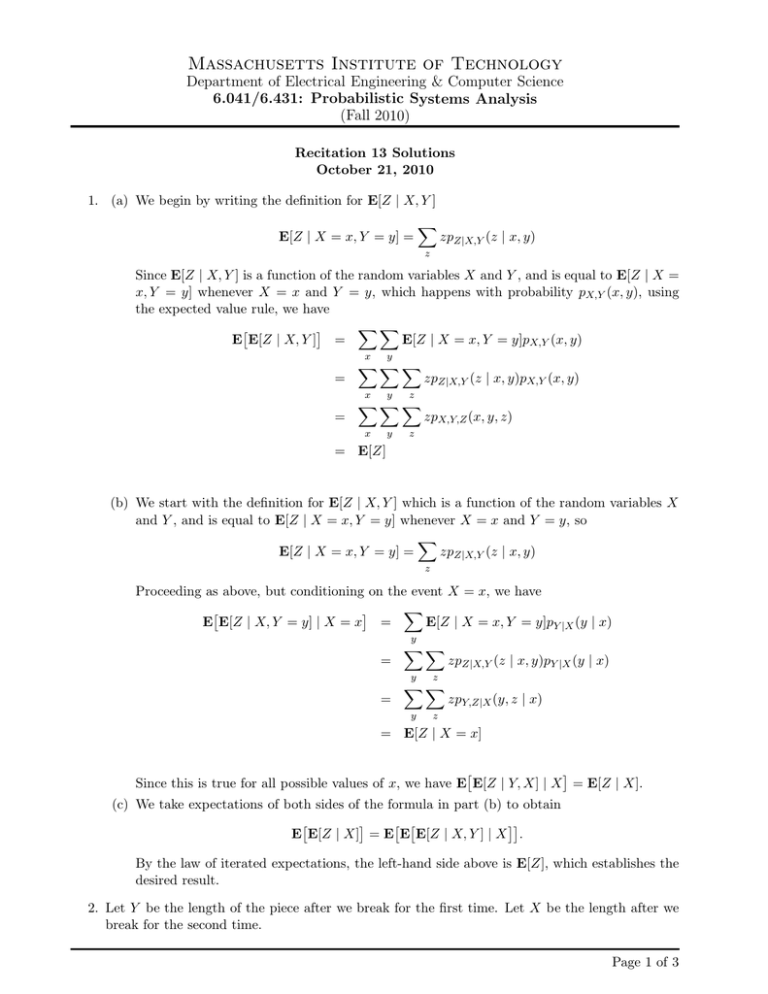
Massachusetts Institute of Technology Department of Electrical Engineering & Computer Science 6.041/6.431: Probabilistic Systems Analysis (Fall 2010) Recitation 13 Solutions October 21, 2010 1. (a) We begin by writing the definition for E[Z | X, Y ] E[Z | X = x, Y = y] = � zpZ|X,Y (z | x, y) z Since E[Z | X, Y ] is a function of the random variables X and Y , and is equal to E[Z | X = x, Y = y] whenever X = x and Y = y, which happens with probability pX,Y (x, y), using the expected value rule, we have �� � � E[Z | X = x, Y = y]pX,Y (x, y) E E[Z | X, Y ] = x = y ��� x = y ��� x y zpZ|X,Y (z | x, y)pX,Y (x, y) z zpX,Y,Z (x, y, z) z = E[Z] (b) We start with the definition for E[Z | X, Y ] which is a function of the random variables X and Y , and is equal to E[Z | X = x, Y = y] whenever X = x and Y = y, so � zpZ|X,Y (z | x, y) E[Z | X = x, Y = y] = z Proceeding as above, but conditioning on the event X = x, we have � � � E[Z | X = x, Y = y]pY |X (y | x) E E[Z | X, Y = y] | X = x = y = �� y = �� y zpZ|X,Y (z | x, y)pY |X (y | x) z zpY,Z|X (y, z | x) z = E[Z | X = x] � � Since this is true for all possible values of x, we have E E[Z | Y, X] | X = E[Z | X]. (c) We take expectations of both sides of the formula in part (b) to obtain � � � � �� E E[Z | X] = E E E[Z | X, Y ] | X . By the law of iterated expectations, the left-hand side above is E[Z], which establishes the desired result. 2. Let Y be the length of the piece after we break for the first time. Let X be the length after we break for the second time. Page 1 of 3 Massachusetts Institute of Technology Department of Electrical Engineering & Computer Science 6.041/6.431: Probabilistic Systems Analysis (Fall 2010) (a) The law of iterated expectations states: E[X] = E[E[X|Y ]] We have E[X|Y ] = Y 2 and E[Y ] = 2l . So then: E[X] = E[E[X|Y ]] = E[Y /2] = 1 1l l = E[Y ] = 2 22 4 (b) We use the Law of Total Variance to find var(X): var(X) = E[var(X | Y )] + var(E[X | Y ]). Recall that the variance of a uniform random variable distributed over [a, b] is (b − a)2 /12. Since Y is uniformly distributed over [0, ℓ], we have ℓ2 , 12 Y2 . 12 var(Y ) = var(X | Y ) = We know that E[X | Y ] = Y /2, and so var(E[X | Y ]) = var(Y /2) = 1 ℓ2 var(Y ) = . 4 48 Also, E[var(X | Y )] = = = = � Y2 E 12 � ℓ 2 y fY (y)dy 0 12 � 1 1 ℓ 2 · y dy 12 ℓ 0 ℓ2 . 36 � Combining these results, we obtain ℓ2 7ℓ2 ℓ2 + = . 36 48 144 � box. Then T = N i=1 Xi . var(X) = E[var(X | Y )] + var(E[X | Y ]) = 3. Let Xi denote the number of widgets in the ith N � E[T ] = E[E[ Xi |N ]] i=1 N � E[Xi |N ]] = E[ i=1 N � = E[ E[X]] i=1 = E[X] · E[N ] = 100. Page 2 of 3 Massachusetts Institute of Technology Department of Electrical Engineering & Computer Science 6.041/6.431: Probabilistic Systems Analysis (Fall 2010) and, var(T ) = E [var(T |N )] + var (E[T |N ]) � �N �� � �N �� � � + var E Xi |N = E var Xi |N i=1 i=1 = E[N var(X)] + var(N E[X]) = (var(X))E[N ] + (E[X])2 var(N ) = 16 · 10 + 100 · 16 = 1760. Page 3 of 3 MIT OpenCourseWare http://ocw.mit.edu 6.041SC Probabilistic Systems Analysis and Applied Probability Fall 2013 For information about citing these materials or our Terms of Use, visit: http://ocw.mit.edu/terms.
